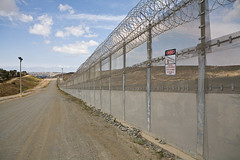House Considers Scrapping Virtual Border Fence
by Adam Hughes*, 9/18/2009
 The Government Accountability Office (GAO) released a new report yesterday before a House Homeland Security Subcommittee hearing on the embattled Secure Border Initiative (SBI) program - a multi-billion dollar program designed to secure the U.S. borders. A subset of that program, called SBInet is supposed to be building a fancy, virtual fence along the U.S. southern border. The program, begun during the Bush administration, has consistently been behind schedule and over budget - and that's when the new technologies have worked at all. And now it looks like Congress may want to cancel the program altogether.
The Government Accountability Office (GAO) released a new report yesterday before a House Homeland Security Subcommittee hearing on the embattled Secure Border Initiative (SBI) program - a multi-billion dollar program designed to secure the U.S. borders. A subset of that program, called SBInet is supposed to be building a fancy, virtual fence along the U.S. southern border. The program, begun during the Bush administration, has consistently been behind schedule and over budget - and that's when the new technologies have worked at all. And now it looks like Congress may want to cancel the program altogether.
Lawmakers might be thinking it's time to pull the plug on SBInet because the update on the project from GAO isn't encouraging:
SBInet technology capabilities have not yet been deployed and delays require Border Patrol, a [U.S. Customs and Border Protection] component, to rely on existing technology for securing the border, rather than using newer technology planned to overcome the existing technology’s limitations. Flaws found in testing and concerns about the impact of placing towers and access roads in environmentally sensitive locations caused delays. As of September 2006, SBInet technology deployment for the southwest border was planned to be complete by early fiscal year 2009. When last reported in February 2009, the completion date had slipped to 2016.
Since SBI's first year, it has received over $3.7 billion in funding, of which about $1.1 billion has been invested in the SBInet program. The delays and cost overruns certainly are not anything new, but another key part of why this program is such a disaster is that the U.S. Customs and Border Protection folks are not even gathering the necessary data to figure out if this is a wise investment. Again from GAO:
CBP reported that tactical infrastructure, coupled with additional trained agents, had increased the miles of the southwest border under control, but despite a $2.4 billion investment, it cannot account separately for the impact of tactical infrastructure. CBP measures miles of tactical infrastructure constructed and has completed analyses intended to show where fencing is more appropriate than other alternatives, such as more personnel, but these analyses were based primarily on the judgment of senior Border Patrol agents.
The hearing in the House Subcommittee on Border, Maritime and Global Counterterrorism of the Homeland Security Committee did not go well for the SBInet program. Lawmakers at the hearing, both Democrat and Republican, were frustrated and angred at the continued delays and problems detailed in the GAO report and some suggested the program may have to be scrapped altogether, including GAO representative Richard Stana. The Subcommittee has archived video of the hearing on its website.
GAO: Technology Deployment Delays Persist and the Impact of Border Fencing Has Not Been Assessed
GAO: Testimony of Richard M. Stana, Director
Homeland Security and Justice Issues
CongressDaily: Lawmakers Suggest Scrapping Border Project
Image by Flickr user waynewhuang used under a Creative Commons license.



